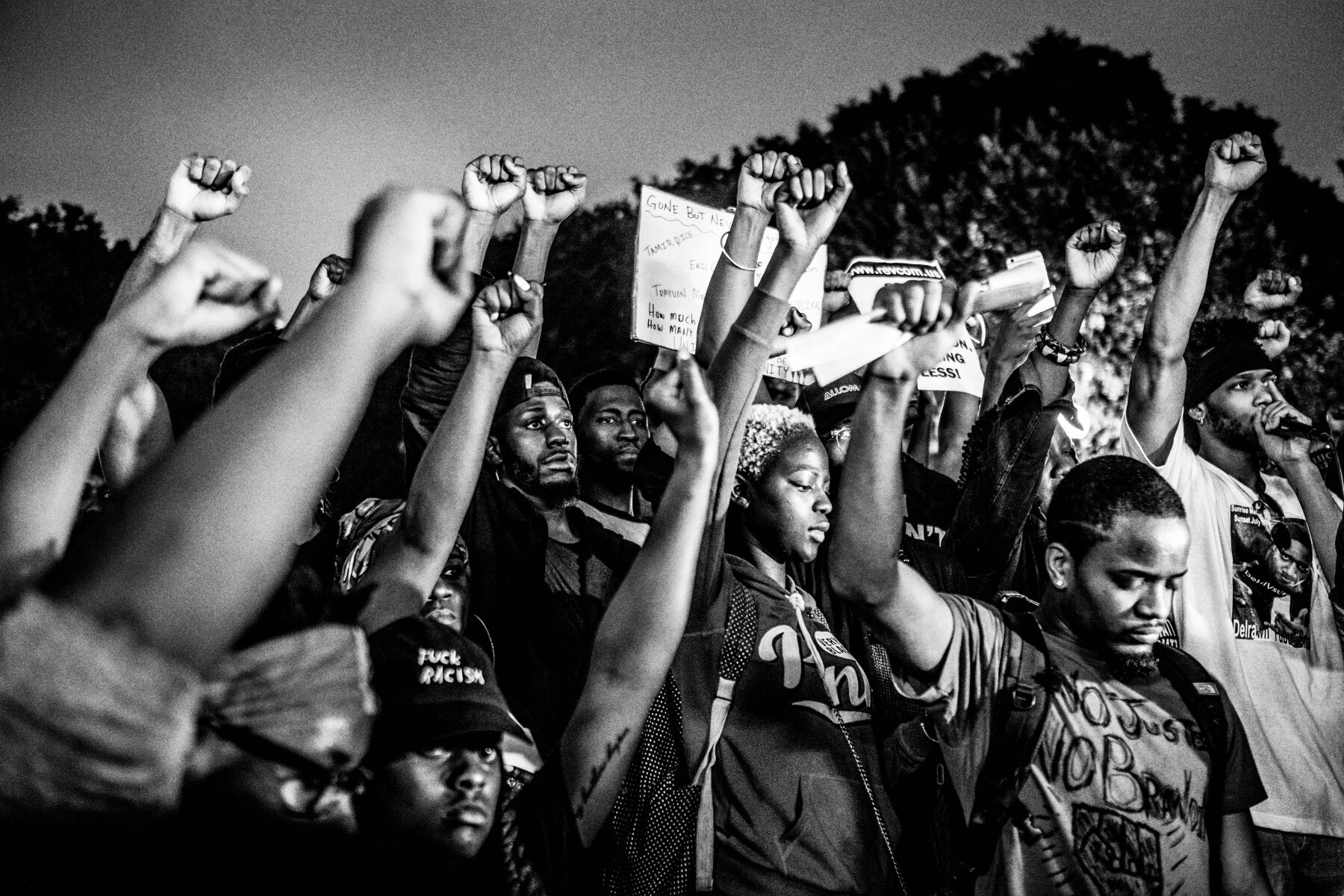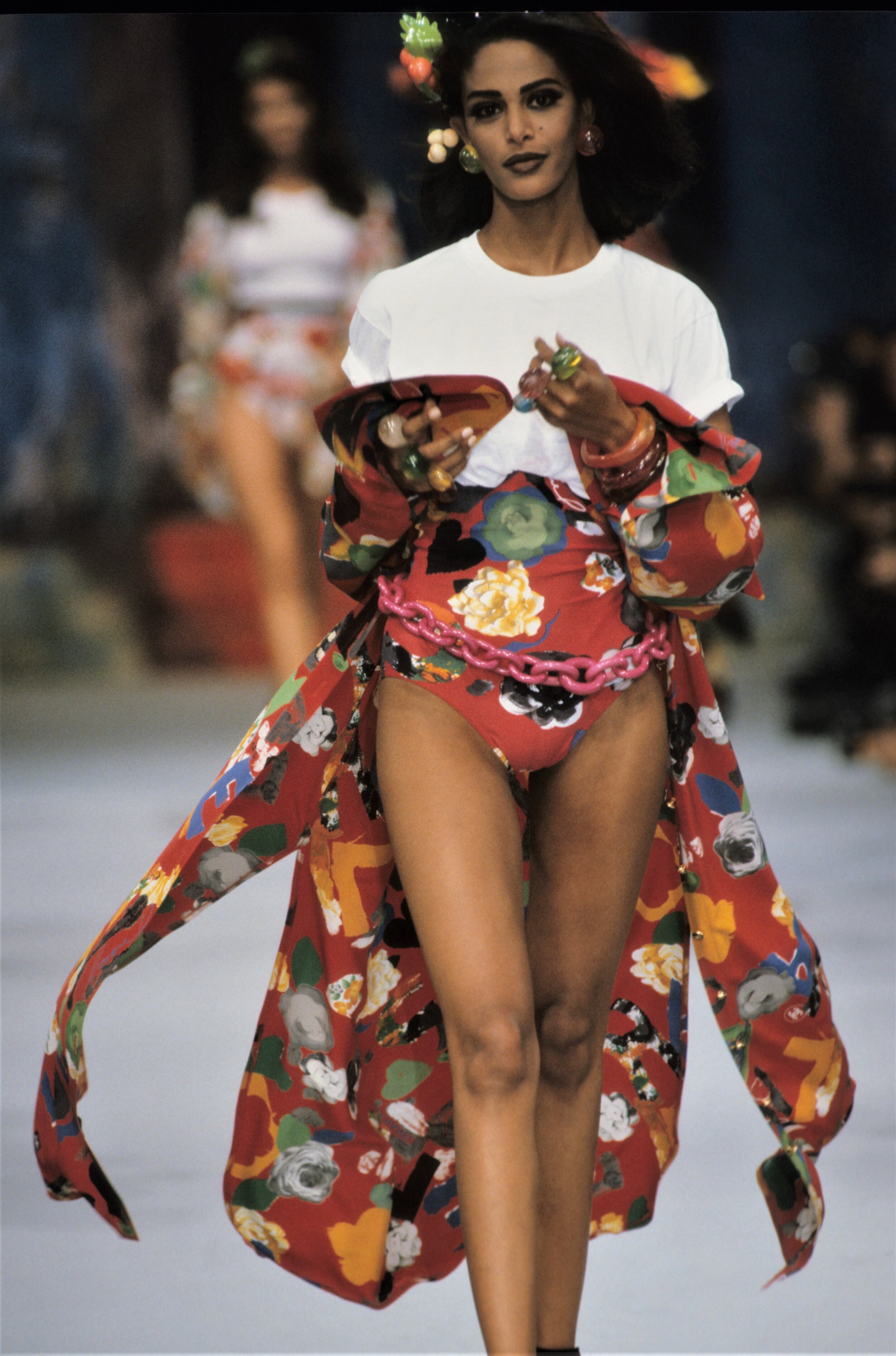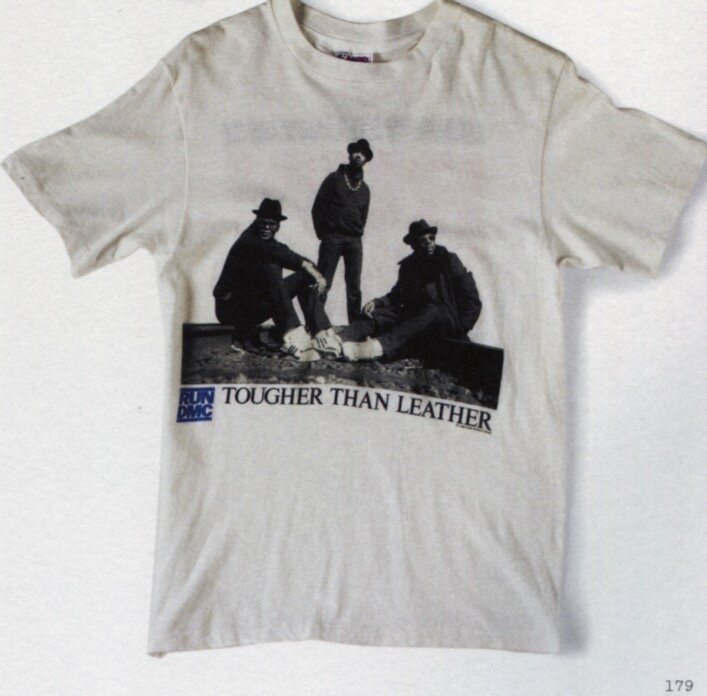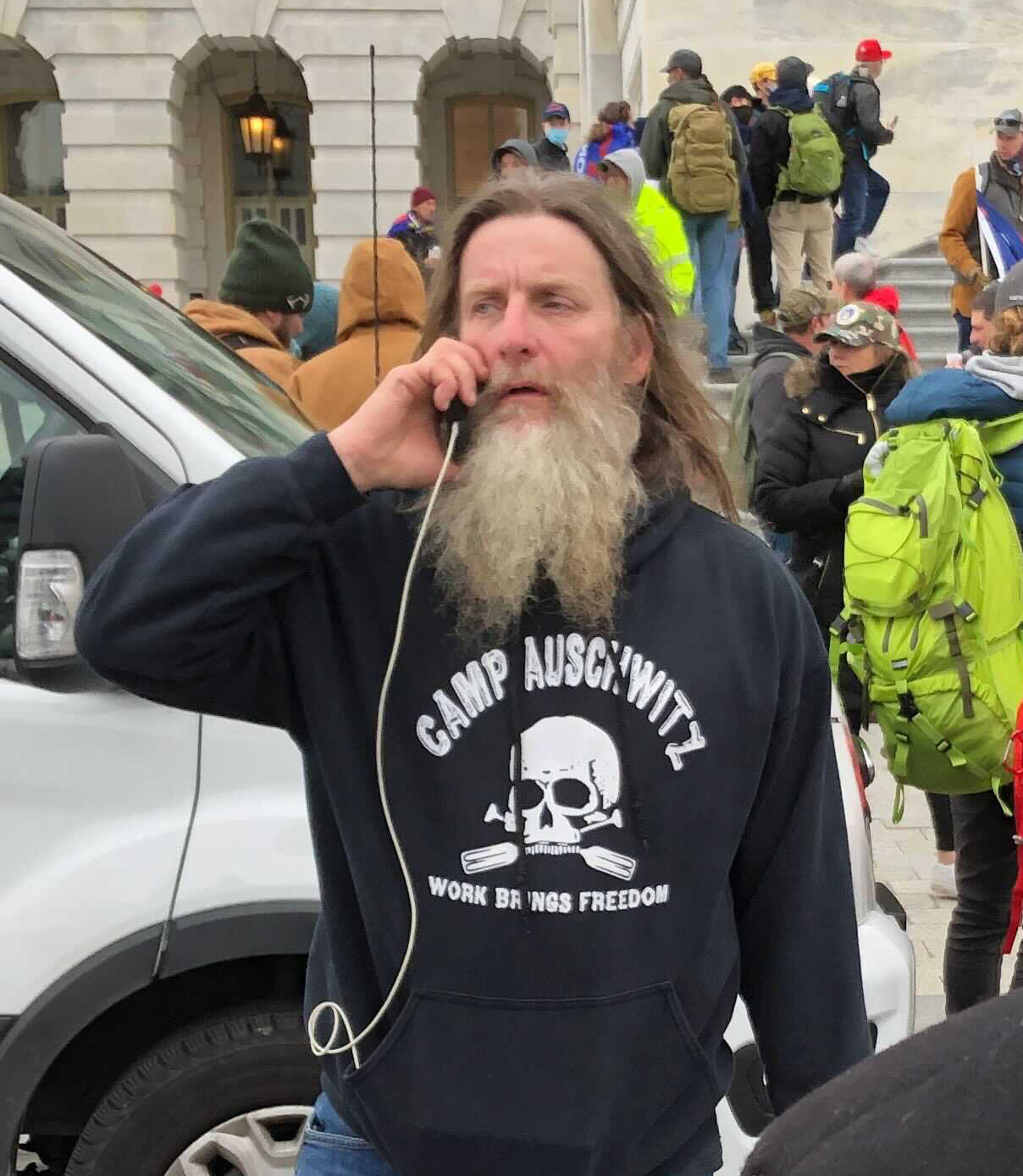The 1990s
Reaganomics and the 1980s changed the way mass markets operated domestically and globally. T-shirts, while still important symbols of personal beliefs, had lost its connection to radical theatrics. A minority few stayed true to the origins of the protest t-shirt of the late 1960s, but branding became more prominent as the apparel industry continued to grow. What a T-shirt said or projected about the wearer was more reliant on a logo than any cause it could promote.[1] While many consumers could promote artists and current events through the medium, T-shirts failed to make the political statement they would have a decade prior. Ultimately, the most notable garment of the decade was the blue dress owned by Monica Lewinsky that entangled President Bill Clinton in scandal, not a cheap T-shirt.
Images from the Chanel Spring 1992 Ready-to-Wear show, featuring T-shirts and apparel printed with the brand logo.
Branding on t-shirts was not a new concept, the relationship between the two had been formed by California surfer shops in the late 1940s. Throughout the late 1970s and 1980s branding become increasingly important in streetwear.
The 1990s ushered in a new phase of this relationship when t-shirts made a debut on the runway with the Chanel Spring/Summer 1992 collection.[2] High end brands now adopted tees to promote their image. For the average person, a plain t-shirt with a printed logo was the cheapest item available from a luxury brand. It bridged the gap between those at the edge of access and those with excess. For those still unable to afford the cheapest items from a brand, issues of classism and racism emerged.

Still of the Rodney King video captured by George Holliday that sparked worldwide backlash. Courtesy of NPR.
On April 29, 1992, Los Angeles erupted in flames as the news that four officers accused of beating Rodney King, an African American, were acquitted.
King had become the face of police brutality when his beating at the hands of the Los Angeles Police Department (LAPD) in March 1991 was captured on camera by bystander George Holliday.
background: aerial shot of Los Angeles during the riots. Courtesy of The Los Angeles Times.
Archival NBC News footage from the 1992 Los Angeles Riots focusing on the effects looting had on the community.
King’s harrowing experience left him with permanent nerve damage in his face and multiple broken bones. It was not unique for African Americans living under the jurisdiction of the LAPD,[3] but it was the first time such an incident had received widespread backlash. News outlets across the country had obtained the tape. The Rodney King Riots brought six days of chaos to Los Angeles, centred at the intersection of Florence St. and Normandie St., a predominantly black neighborhood. It was the first race riot in the city since 1968. On the first night of the riots, looting had begun. Protestors began stealing brand name appliances, electronics and apparel from big box stores.
While some kept the items for personal use, most was intended to be sold elsewhere. [4] The Rodney King Riots was a complex, multi-racial event that included members of the African American, white, Latino and Korean communities in Los Angeles. One that symbolized a nation which had continued to outgrow an antiquated system based on the preferential treatment of white men since the Civil Rights Movement. The looting was a small part of the violence, to which the police and fire department stopped responding.[5] The city was left with sixty four dead, thousands wounded and over one billion dollars in damage.
Looters seen loading their car with stolen goods.
Rodney King makes a public plea on May 1, 1992 for peace, asking “Can’t we all just get along?”
A flaming car sits in the Florence and Normandie intersection.
The 1990s were defined by the intersection of technology, media and personal expression. Protest music permeated the private sphere in new ways, and was often subliminal. Dissent had found a safe haven in the hyperspace on Music TeleVision (MTV).
Originally entering the air waves in 1981, MTV was an immediate success. By the mid-1990s, MTV had changed some of its programming to reality tv, but music videos remained central to the MTV identity. Music videos were no longer consisted of filmed performances, but full scale productions with sets, costumes, story lines and effects.[6] The two most prevalent genres of the decade, hip-hop and grunge, utilized MTV to spread their dissenting message.
(above) MTV Logo t-shirt, c. 1985. The MTV logo became a quickly popular image on t-shirts when it entered the airwaves in 1981
(below) RUN DMC t-shirts, c.1990. American rap group RUN DMC were the first black rap artists to appear on MTV in 1984.
Tupac Shakur T-shirt, front and back, 1990s.
Commemorative T-Shirt for The Notorious BIG following his death in 1997. Late 1990s.
Race relations in the United States would not improve after the Los Angeles King riots. The policies in Reagan’s War Against Crime incarcerated millions and led to immense stress on the prison system. In response to the overflow of inmates, the Clinton administration reallocated funds from public housing to reinforce existing prisons and build new ones.[7] President Clinton was constantly engulfed by personal scandals, most infamously with White House intern Monica Lewinsky in 1997, and perhaps too busy to adequately resolve the issue.
Hip-hop and rap, an underground phenomena that had been developing for several generations, gave a marginalized community of African Americans an outlet to vent frustrations with the system. The Notorious BIG, Wu-Tang Clan, NWA and Tupac Shakur dominated the airwaves with messaging about the experiences of the underprivileged, conditions that had not improved for decades. Those that identified with these messages could wear t-shirts promoting their favourite artists.
Grunge music, carried by the band Nirvana and infamous frontman Kurt Cobain, drew on similar criticisms of the establishment and expression of ideas as rap and hip hop. Grunge had also found a home on MTV, where the music video for Smells Like Teen Spirit was in frequent demand, and fans could identify themselves wearing band apparel.
The grunge movement came from working class communities, who had not benefited from Reaganomics like those involved with Wall Street.[8] Grunge music often addressed themes of disillusionment, the inherent hypocrisy of commercialism and general dissatisfaction with life itself. The “Seattle Sound”[9] lost momentum with the death of Cobain in 1994, and by the end of the decade become obsolete.
Nirvana T-shirt, front and back, 1996.

The protest T-shirt would introduce a level of irony through the success of the Che Guevara image in the 1990s. It speaks to the often-paradoxical nature of how protest T-shirts have been commodified, even co-opted, over the years by consumer capitalism. An image of Guevara taken at a funeral service in 1960 by photographer Alberto Karda, titled Guerrillero Heroico, had become a commercial success in the United States and globally.[10] Guevara was an icon of rebellion and revolution, having aided the Castro Brothers in the overtaking of Cuba in 1959 and establishing a communist regime.
Guevara himself was not a fan of American rebellion, once remarking that if you “asked American leftists to form a firing squad, they’d get into a circle.”[11] The popularity of Guevara’s image exemplifies the state of the protest t-shirt at the turn of the millennium. It exists, but only as an illusion of what it once was. While those that purchased Guevara ephemera wanted to align themselves with a radical revolutionary, many glossed over the inherent irony of promoting a radical communist on a shirt they bought in a shopping mall.
Background: The contact sheet taken by Alberto Karda that contains the original Guerillo Heroico image, 1960.
Rapper Jay-Z wearing a Che Guevara T-shirt, late 1990s.
Merchandise for band Rage Against the Machine, featuring the image of Che Guevara. Late 1990s.
In the decades that followed the 1990s, political and protest T-shirts continued to speak to the masses. The rise and proliferation of the internet into everyday life has given the protest T-shirt a shorter shelf life. A T-shirt calling for peace and love in the 1960s that could speak to all eras has been replaced by the hyper specific identification of current issues.
Breonna Taylor protest T-shirt, front and back, 2020.
In more recent memory the Black Lives Matter protests of summer 2020, in response to the murders of Breonna Taylor and George Floyd at the hands of the authorities, sparked the production of several T-shirts.
Man wearing a “MAGA: Civil War” T-Shirt worn at Capitol Riots, Jan 6, 2021.
Man wearing a “Camp Auschwitz: Work Brings Freedom” At the Capitol Riots, Jan 6, 2021.
On January 6, 2021, right wing radicals stormed the US Capitol Building in Washington D.C in an attempt to thwart the election of President Joe Biden. Many attended the event wearing T-shirts declaring “Civil War” and glorifying the concentration camps used for the Holocaust during the Second World War.
Both of these movements facilitated discussion about the ethics of commercially made protest T-shirts, resulting in the removal of some from online retailers.[12][13]

Protest T-shirts are more accessible than ever, but it comes with a price.
They are available to those fighting for equality and democracy and to those fighting against it.
Democracy and free speech are a packaged deal, a principle that must be constantly reinforced. But for the times voices cannot be heard over the noise, we can always wear a T-shirt.
Previous: The 1980s
Background: Black Lives Matter protest, New York City, July 2016.
Notes
[1] Neil, Boorman. “The slogan t-shirt’s relationship to branding” Slogan T-Shirts: Cult and Culture, 48
[2] Marc Guetta, Patrick Guetta and Alison A Neider. Vintage T-Shirts, 12
[3] The LAPD chief of police had a history of recruiting officers from the South for their oppressive tactics towards marginalized groups. Esperanza, Nina Serianne. America in the Nineties. (Syracuse University Press, 2015), 175
[4] Esperanza, Nina Serianna. America in the Nineties, 178
[5] Esperanza, Nina Serianna. America in the Nineties, 177
[6] Esperanza, Nina Serianna. America in the Nineties, 143
[7] Esperanza, Nina Serianna. America in the Nineties, 185.
[8] Esperanza, Nina Serianna. America in the Nineties, 142
[9] Esperanza, Nina Serianna. America in the Nineties, 142
[10] Allwood, Emma Hope. “How the Che Guevara t-shirt became a global phenomenon” Dazed Magazine, dazed digital.com. Published 26 July, 2016. Par 2. https://www.dazeddigital.com/fashion/article/32208/1/how-the-che-guevara-t-shirt-became-a-global-phenomenon
[11] Goldberg, Danny. The Lost Chord: 1967 and the Hippie Idea, 20
[12] “Amazon removes t-shirt showing George Floyd death” BBC News, bbc.com. Published 9 June, 2020. https://www.bbc.com/news/technology-52978193
[13] Del Rey, Jason. “Shopify hits President Trump where it hurts: his wallet.” Vox, vox.com. Published Jan 7, 2021. https://www.vox.com/recode/22218863/shopify-bans-trump-store-merch-capitol-facebook-twitter
Images and Media
Chanel Spring/Summer 1992 Runway, Vogue.com, from the Condé Nast Archives.
Still from the George Holliday video of Rodney King, 1991, The Los Angeles Times, latimes.com
Aerial view of Los Angeles during the riots, 1992, Los Angeles Times. Image by Ken Lubas.
NBC Nightly News, “LA Riot Looters: ‘A Colourblind Orgy of Wrecking and Taking.” Youtube.com
Looters loading their car during the Rodney King Riots, 1992, npr.org. Image by Ron Eisenberg.
Burned out car at the intersection of of Normandie St. and Florence St. 1992, npr.org. Image by Steve Greyson.
MTV Logo T-shirt, Vintage T-Shirts, 331.
RUN DMC Logo T-shirt, 1980s. Ripped: T-shirt from the Underground, 179.
RUN DMC Band Photo T-Shirt, 1980s, Ripped: T-Shirts from the Underground, 179.
Tupac Shakur T-shirt, 1990s, grailed.com
Commemorative The Notorious BIG T-shirt, late 1990s, grailed.com.
Music video for Nirvana, Smells Like Teen Spirit. Youtube.com.
Nirvana T-shirt, 1996, grailed.com.
Contact sheet by Alberto Karda, 1960, Dazed Magazine, dazeddigital.com.
Rapper Jay-Z in a Che Guevara T-shirt, 1990s, Dazed Magazine, dazeddigtal.com.
Rage Against the Machine Che Guevara T-shirt, defunkd.com
Breonna Taylor Protest T-shirt, 2020, phenomenalwomen.us. Accessed January, 2021.
Protestor in MAGA Civil War T-shirt, 2021. twitter.com, uploaded Jan 6, 2021 by user @willjennings80
Protestor in Camp Auschwitz T-shirt, 2021, nbcnews.com.
Black Lives Matter protest, New York City, July 2016, “A Year Inside The Black Lives Matter Movement” Rolling Stone Magazine. Image by Benedict Evans.




















